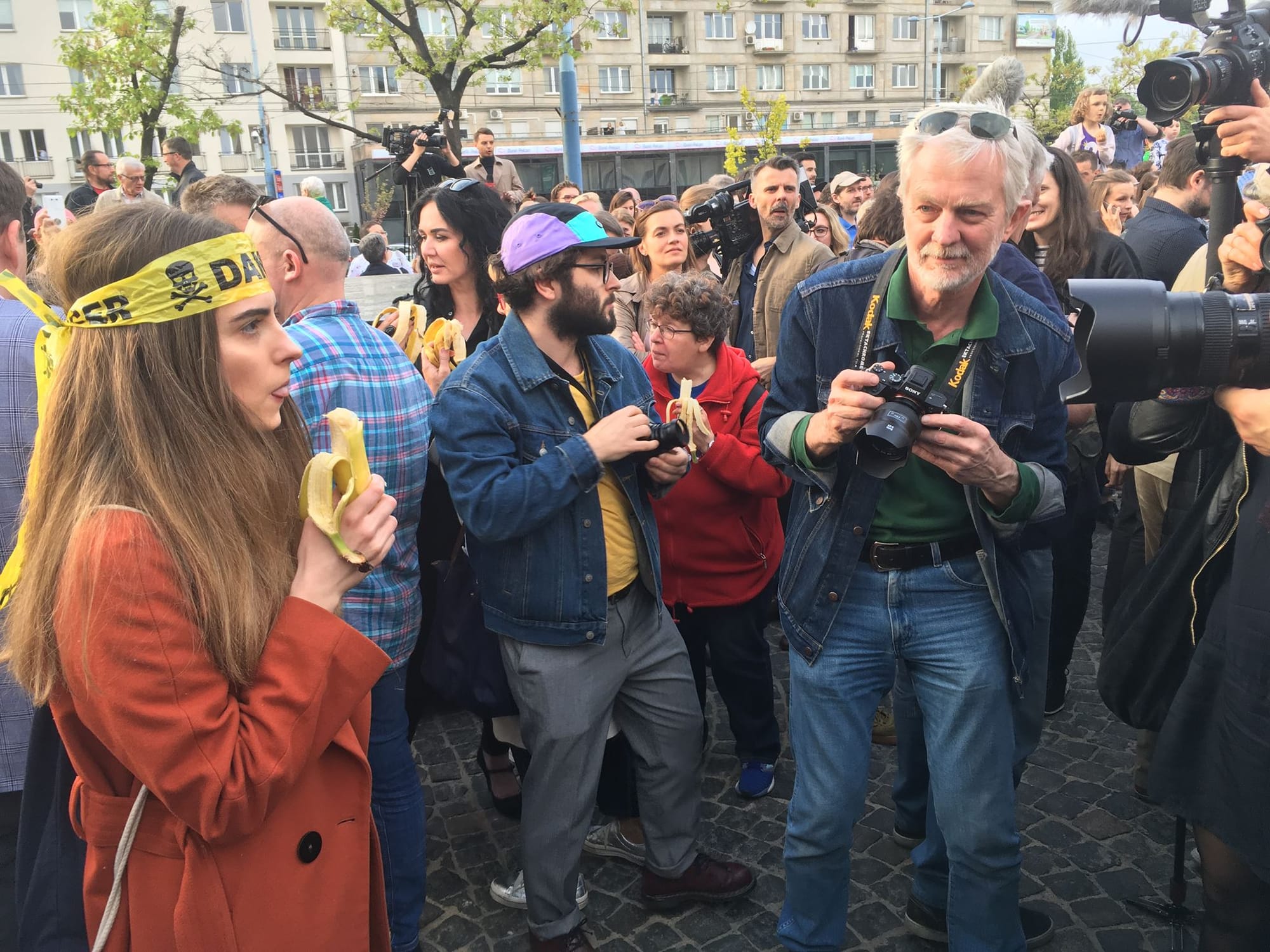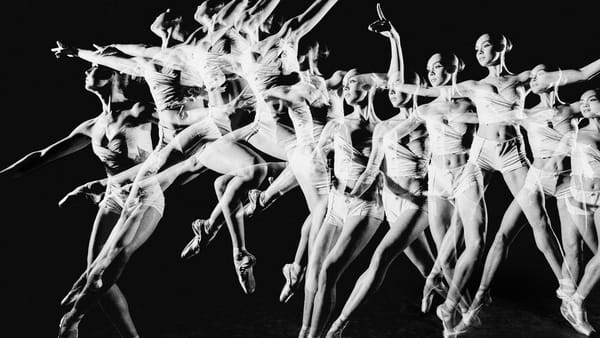Hundreds of Protesters Wielded Bananas After a Polish Museum Censored Feminist Artworks
Following an anonymous complaint, the director of the National Museum in Warsaw took down the works of Natalia LL, Katarzyna Kozyra, and the duo Karolina Wiktor and Aleksandra Kubiak, sparking #bananagate.

Last week, Poland’s National Museum in Warsaw removed, then rehung, the works of three well-known Polish feminist artists — Natalia LL, Katarzyna Kozyra, and the duo Karolina Wiktor and Aleksandra Kubiak — leading to widespread protests across the cultural spectrum and accusations the museum is attempting to censor feminist art in concert with the Ministry of Culture.
In response, a “#bananagate” demonstration was held yesterday in front of the National Museum in Warsaw, along with an open letter denouncing the museum’s move to remove four icons of Polish feminist art history from its walls.
The scandal broke after Polish media outlet Onet announced that the National Museum in Warsaw decided on April 26 to remove Natalia LL’s “Consumer Art” (1973), Katarzyna Kozyra’s “Appearance of Lou Salome” (2005), and Aleksandra Kubiak and Karolina Wiktor’s “Part XL. Tele Game” (2005), citing an anonymous letter received by the museum’s director, Jerzy Miziołek, from a concerned mother who characterized her son’s visit to the museum as “traumatic.”
Citing the museum’s “responsibility” to “children and teenagers,” Miziołek took down the works without warning and said he will be replacing them with other artworks from the museum’s collection.
In Katarzyna Kozyra’s video “Performance as Lou Salome” (2005) a video installation documenting a performance she did around the Schwarzenberg garden and palace in Vienna, the issue seems to be the connotation in the work comparing men and dogs. Kozyra’s original idea included transforming Friedrich Nietzsche and Rainer Maria Rilke into dogs, situating herself in the guise of a whip-wielding femme fatale in control of the philosophical greats, depicted in the film as dogs on a leash. In one noteworthy shot, the animals are shown having sex doggy style on the lush green grass in front of the palace. Kozyra then re-enters the frame with her whip to discipline the lust-fueled romp.
In Natalia LL’s 1973 video “Consumer Art,” the most well-known work censored last week, a naked woman is depicted eating a banana in a suggestive manner. The double meaning of the banana as a phallic object, but also an object of foreignness, luxury, and desire under Soviet Communism, caused a stir when it was first exhibited in the 1970s.
In a statement posted to the museum’s website on Monday, Miziolek said he is “opposed of showing works that could irritate sensitive young people.” The banana in Natalia LL’s film has — in effect — become the symbol of the protest movement against the silencing of Poland’s most well-known and respected feminist artists.
Documentation of a women’s day performance by Karolina Wiktor and Aleksandra Kubiak was also removed last week on Miziolek’s demands. The work in question is another documentation of a performance, called Part XL. Tele Game, from 2005. In it, the artists conduct via a film stream of their studio a call-in performance, which allowed viewers to become participating by calling in to suggest performances and gestures for the artists to enact live. The artists then compulsorily “gave themselves” to the power of those who called in, realizing their hidden wishes and desire. Thanks to the anonymity of the telephone, participants had the opportunity to express deeply held — and often disturbing — desires. Once again, the work deals mostly with the dynamics of power, domination, and sexual desire, which seems to be the thread holding together all three works removed last week.
All of them, it should be noted, remain in the collection of the museum, they haven’t been deaccessioned, nor is there any talk for them to be.
What these works all have in common, however, are sexually ambivalent themes that problematize the role of gender and power.
Karol Radziszewski, founder and curator of the Queer Archives Institute based in Warsaw, also encountered censorship in 2009 after a mural he had proposed to the Warsaw Uprising Museum was accepted and then rejected for containing homoerotic themes. “Censorship in Poland is usually hidden,” he said to Hyperallergic via Facebook Messenger.
Radziszewski, who spoke out in support of those targeted last week, added that the situation in many Polish institutions leads to widespread uncertainty and fear among artists and curators. “If the curator or institution is too fearful, they are not going to invite ‘troublesome artists’,” he said, noticing that themes such as gender are subject to harsh critique and erasure. “It’s shocking and perhaps shows a new direction of current government that will openly and directly confront us with its conservative, patriarchal and violent vision of Polish culture,” Radziszewski lamented.

Agata Jakubowska, a professor at the Adam Mickiewicz University in Poznań and editor of recent reader on Natalia LL Consumer Art and Beyond (2015), concurred with Radziszewski, saying in an email to Hyperallergic that #bananagate is patently an “act of censorship that is in accordance with the conservative politics of the current Polish government.”
Famed collector of Polish feminist art, Grazyna Kulczyk, agreed, stating in an email sent to Hyperallergic that “contemporary art does not need to be well-mannered. It needs to stir emotions and address issues that are not universally accepted — because of the means of expression used or the subject matter explored.”
“Kulczyk battled censorship before, but it has never prevented her from championing the works of artists she admires
Kulczyk went on to state that while she has been battling censorship in the Polish art world since the 1960s, that this has not prevented her from championing the works of artists she admires. In 2013, she acquired Natalia LL’s Consumer Art, which is now the center of a new exhibition at the Muzeum Susch (which she founded) in Engadin Valley (A Woman Looking at Men Looking at Women, curated by Kasia Redzisz).
“Then, just as now, what is at stake is to challenge the traditional male domination,” Kulczyk said. “To provoke a discussion on a topical matter is one of art’s essential tasks, one that should not be shunned by those at the helm of cultural institutions.”
The Ministry of Culture and National Heritage denies having any involvement in censoring the works or changing the content of the 20th and 21st-century gallery rooms within the National Museum. On Monday, the ministry issued a press release stating that the overall responsibility of the museum falls with the responsibility of its director, denying it had any involvement with the decision made by Miziołek last week.
Yet while the ministry claims to assert no control over the programming of institutions, it is within the sole mandate of the Minister of Culture, Piotr Gliński, a member of the ruling PiS political party (Law and Justice party), to appoint and dismiss the heads of institutions, as well as to control their budgets. This gives them considerable sway when it comes to indirectly influencing cultural policy. As recently as last month, Gliński’s was accused of attempting to wrest control of the European Solidarity Centre in Gdańsk in order to bring its programming closer into the orbit of PiS’s conservative-leaning ideology.
What’s clear, however, is that in an attempt to quietly shelve these works, the National Museum has done just the opposite, amplifying them to viral, meme-worthy proportions. Within hours of the #bananagate hashtag appearing online, the story had been picked up major international media like the Washington Post, BBC, and the CNN. Viral stories, click-bait, and memes aside, the works have now transcended the discursive lexicon of Polish feminist art, entering into a wider and more ambivalent culture war that appears far, far from over.
Responding to the censure of the feminist works and the later decision to rehang them, Agnieszka Rayzacher, Paulina Ołowska, and Monika Fabijańska decided to issue a “Letter of Belief.” Together with numerous other cultural luminaries from Poland and around the world, including AA Bronson and Claire Bishop, the letter renounces censorship and political interference in Poland’s cultural institutions.
With a dose of relief, we accept the statement of April 29, 2018 by director of the National Museum in Warsaw, professor Jerzy Miziołek, in which he informed about the temporary return of the works by Polish women artists removed on Friday from the Gallery of 20th and 21st Century Art. The artworks removed from the exhibition are part of the collection of the National Museum in Warsaw and have been presented numerous times in the most important art institutions worldwide, including at Tate, Centre Pompidou, and the Brooklyn Museum.
We oppose censorship of culture and interference with artists’ right to freedom of expression and the right of the viewers to unrestricted choice regarding art they can see at art institutions and its interpretation. Acts of censorship deprive artists of the freedom of expression and in this case also deprive women of their voice. We express our hope that in the new arrangements of the gallery – currently being prepared at prof. Miziołek initiative – the works by women, including feminist artists, will not be censored but will be shown in its fully deserved place.
Editor’s note 5/1/19 11:38am: This article has been updated to indicate that the open letter was initiated by Agnieszka Rayzacher, Paulina Ołowska, and Monika Fabijańska, not Natalia LL.





